Ich erinnere mich noch gut an die Frustration, als ich einen meiner ersten Blogbeiträge auf Facebook teilte und nur ein völlig zufälliges, verpixeltes Bild angezeigt wurde. Nachdem ich Stunden in den Inhalt investiert hatte, war es entmutigend zu sehen, wie er falsch dargestellt wurde, bevor überhaupt jemand die Chance hatte, darauf zu klicken.
Das passiert, wenn eine Website Social-Media-Plattformen keine klaren Anweisungen gibt, was angezeigt werden soll. Ohne diese Anleitung muss Facebook raten, und es rät oft falsch.
Hier bei WPBeginner haben wir gemeistert, wie wir unser Social-Sharing-Erscheinungsbild mit Open-Graph-Metadaten steuern. In diesem Leitfaden führen wir Sie durch die bewährten Methoden, die wir verwenden, damit Ihre Inhalte immer bestmöglich aussehen, wenn sie geteilt werden.
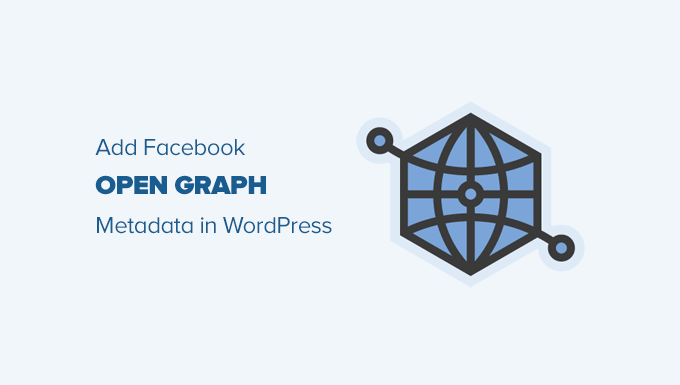
Sie können die untenstehenden Schnelllinks verwenden, um direkt zu der Methode zu springen, die Sie am meisten interessiert:
- Hinzufügen von Facebook Open Graph Metadaten mit AIOSEO
- Facebook Open Graph-Metadaten mit Yoast SEO festlegen
- Hinzufügen von Facebook Open Graph Metadaten mit Code
- Häufig gestellte Fragen zu Facebook Open Graph
- Zusätzliche Ressourcen zu Facebook und WordPress
Wichtig: Bitte wählen Sie nur eine der folgenden Methoden. Die Verwendung mehrerer SEO-Plugins oder das manuelle Hinzufügen von Code, während ein Plugin aktiv ist, kann zu widersprüchlichen Open-Graph-Tags führen, was zu unerwarteten Sharing-Ergebnissen führen kann. Wir empfehlen Methode 1 mit AIOSEO für die einfachste und umfassendste Einrichtung.
Methode 1: Hinzufügen von Facebook Open Graph-Metadaten mit AIOSEO
All in One SEO ist ein beliebtes WordPress SEO-Plugin, das von über 3 Millionen Websites genutzt wird. Es ermöglicht Ihnen, Ihre Website einfach für Suchmaschinen sowie soziale Plattformen wie Facebook und Twitter zu optimieren.
Zuerst müssen Sie das kostenlose All in One SEO-Plugin installieren und aktivieren. Weitere Details finden Sie in unserer Schritt-für-Schritt-Anleitung zur Installation eines WordPress-Plugins.
Upon activation, you need to visit the All in One SEO » Social Networks page. Here, you can enter your Facebook page URL and all your other social networks.
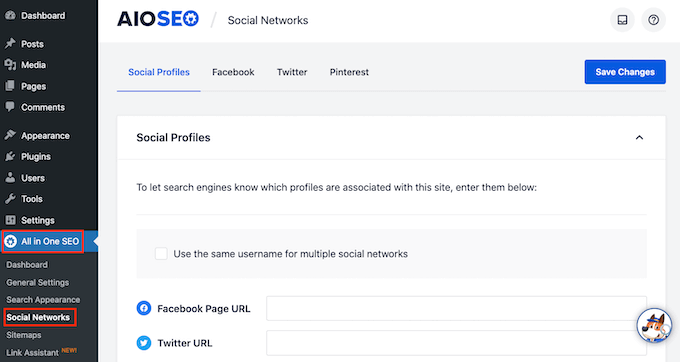
Klicken Sie als Nächstes auf den Facebook-Tab oben auf der Seite, und Sie sehen, dass Open Graph Markup standardmäßig aktiviert ist.
Sie können auf die Schaltfläche 'Bild hochladen oder auswählen' klicken, um ein Standard-Facebook-OG-Bild auszuwählen, wenn ein Artikel kein Open-Graph-Bild hat.
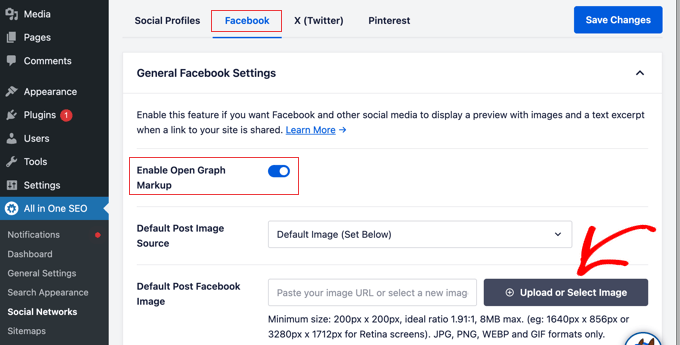
Wenn Sie nach unten scrollen, können Sie den Namen Ihrer Website, die Beschreibung und weitere Einstellungen anpassen. Vergessen Sie nicht, auf die blaue Schaltfläche „Änderungen speichern“ zu klicken, sobald Sie fertig sind.
Nachdem Sie nun Website-weite Open Graph Metatags festgelegt haben, besteht der nächste Schritt darin, Open Graph Metadaten für einzelne Beiträge und Seiten hinzuzufügen.
Standardmäßig verwendet AIOSEO den SEO-Titel und die Meta-Beschreibung Ihres Beitrags für den Open-Graph-Titel und die Beschreibung. Sie können auch manuell das Facebook-Thumbnail für jede Seite und jeden Beitrag festlegen.
Bearbeiten Sie einfach den Beitrag oder die Seite und scrollen Sie nach unten zum Abschnitt „AIOSEO-Einstellungen“ unterhalb des Editors. Wechseln Sie von hier aus zur Registerkarte „Soziales“, und Sie sehen eine Vorschau Ihres Thumbnails.
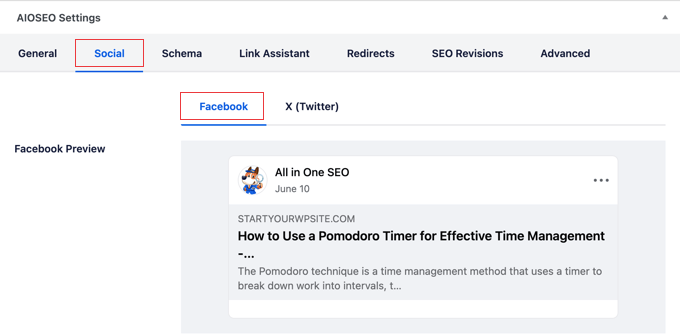
Hier können Sie das Social-Media-Bild sowie den Titel und die Beschreibung festlegen.
Scrollen Sie einfach nach unten zum Feld „Bildquelle“. Sie können das Beitragsbild verwenden, ein benutzerdefiniertes Bild hochladen oder andere Optionen wählen.
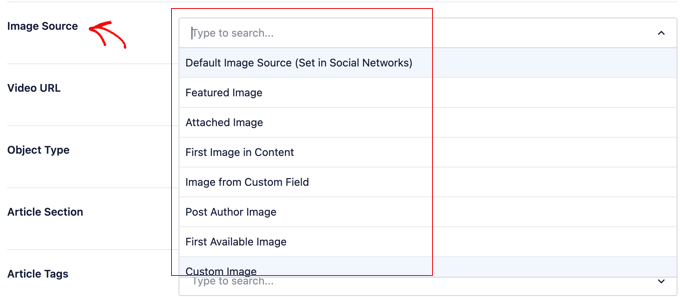
Methode 2: Facebook Open Graph-Metadaten mit Yoast SEO festlegen
Yoast SEO ist ein weiteres WordPress SEO Plugin, das Sie verwenden können, um Facebook Open Graph Metadaten zu jeder WordPress-Website hinzuzufügen.
Das Erste, was Sie tun müssen, ist das Yoast SEO Plugin zu installieren und zu aktivieren. Weitere Details finden Sie in unserer Schritt-für-Schritt-Anleitung zur Installation eines WordPress-Plugins.
Nach der Aktivierung sind die Facebook Open Graph-Daten standardmäßig aktiviert.
Sie können dies überprüfen, indem Sie zu Yoast SEO » Einstellungen gehen und zum Abschnitt Social Sharing scrollen. Stellen Sie nun sicher, dass die Funktion für Open Graph-Daten aktiviert ist.
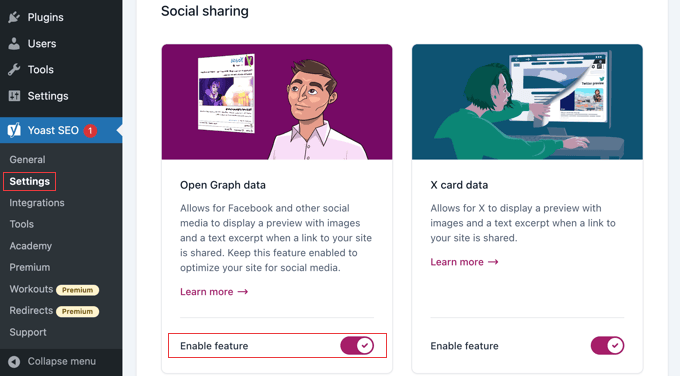
Sie können Ihre Einstellungen speichern oder fortfahren und andere Facebook-Social-Optionen konfigurieren.
Sie können eine Facebook-App-ID angeben, wenn Sie eine für Ihre Facebook-Seite und Einblicke verwenden. Sie können auch den Open Graph-Meta-Titel, die Beschreibung und das Bild Ihrer Homepage ändern.
Schließlich können Sie ein Standardbild festlegen, das verwendet wird, wenn für einen Beitrag oder eine Seite kein Bild festgelegt ist.
Die Premium-Version von Yoast SEO ermöglicht es Ihnen auch, Open Graph-Metadaten für einzelne Beiträge und Seiten festzulegen. Bearbeiten Sie einfach einen Beitrag oder eine Seite und scrollen Sie nach unten zum Abschnitt „Yoast SEO“ unterhalb des Editors.
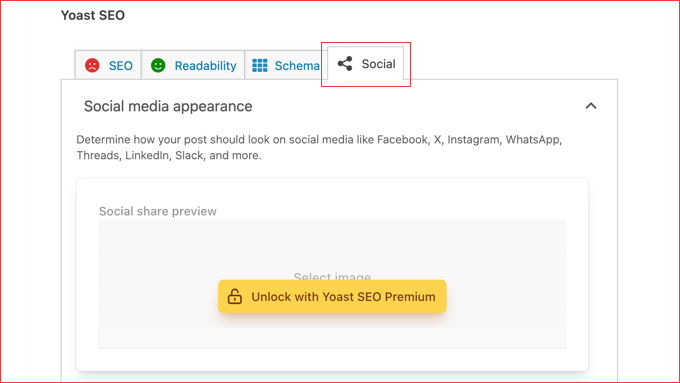
Von hier aus können Sie ein Facebook-Thumbnail für diesen speziellen Beitrag oder diese Seite festlegen. Wenn Sie keinen Beitragstitel oder keine Beschreibung festlegen, verwendet das Plugin Ihren SEO-Meta-Titel und Ihre Meta-Beschreibung.
Sie können Ihren Beitrag oder Ihre Seite jetzt speichern, und das Plugin speichert Ihre Facebook Open Graph-Metadaten.
Methode 3: Hinzufügen von Facebook Open Graph-Metadaten per Code
Diese Methode erfordert normalerweise, dass Sie Code in die Datei functions.php Ihres Themes kopieren und einfügen. Wir empfehlen jedoch, den Code stattdessen mit dem WPCode-Plugin hinzuzufügen, was das Hinzufügen von benutzerdefiniertem Code in WordPress einfacher und sicherer macht.
WPCode enthält auch eine Bibliothek mit fertigen Code-Snippets, darunter eines zum Hinzufügen grundlegender Open-Graph-Tags, sodass es nur wenige Klicks erfordert.
Installieren und aktivieren Sie zuerst das kostenlose WPCode-Plugin. Weitere Details finden Sie in unserem Leitfaden zur Installation eines WordPress-Plugins.
Nach der Aktivierung können Sie in Ihrem WordPress-Dashboard zu Code Snippets » + Snippet hinzufügen navigieren.
Suchen Sie im Bibliotheksbereich nach dem Snippet „Add basic Open Graph Tags“. Sobald Sie es gefunden haben, fahren Sie mit der Maus darüber und klicken Sie auf die Schaltfläche „Snippet verwenden“.
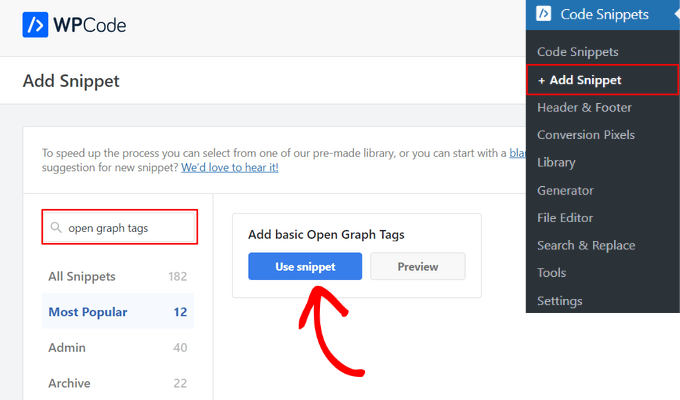
Dann fügt WPCode den Code automatisch für Sie hinzu und legt die Website-weite Kopfzeile als Einfügungsmethode fest.
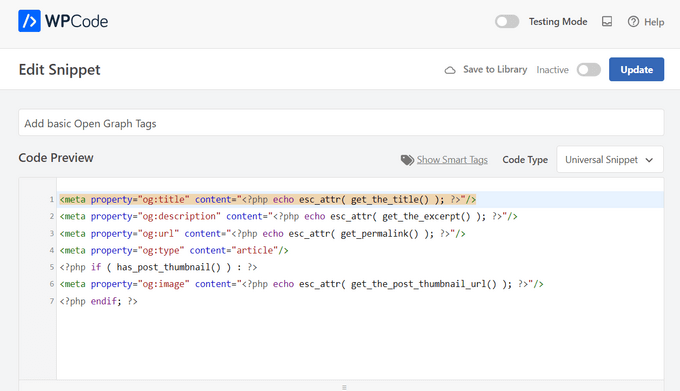
Danach müssen Sie nur noch den Snippet auf „Aktiv“ umschalten und auf die Schaltfläche „Aktualisieren“ klicken. Ihr Theme zeigt nun Facebook Open Graph Metadaten im WordPress-Header an.
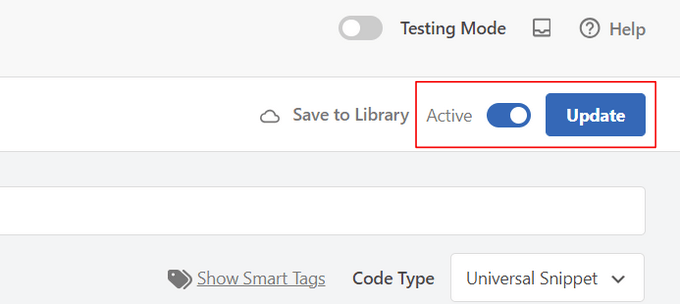
Wenn Sie ein fortgeschrittener Benutzer sind, können Sie den folgenden Code immer noch kopieren und in die functions.php-Datei Ihres Themes einfügen.
Da dies erfordert, dass Sie Ihre Theme-Dateien direkt bearbeiten, stellen Sie sicher, dass Sie eine Sicherung Ihrer Theme-Dateien erstellen, bevor Sie Änderungen vornehmen.
//Adding the Open Graph in the Language Attributes
function add_opengraph_doctype( $output ) {
return $output . ' xmlns:og="http://opengraphprotocol.org/schema/" xmlns:fb="http://www.facebook.com/2008/fbml"';
}
add_filter('language_attributes', 'add_opengraph_doctype');
//Lets add Open Graph Meta Info
function insert_fb_in_head() {
global $post;
if ( !is_singular()) //if it is not a post or a page
return;
echo '<meta property="fb:app_id" content="Your Facebook App ID" />';
echo '<meta property="og:title" content="' . get_the_title() . '"/>';
echo '<meta property="og:type" content="article"/>';
echo '<meta property="og:url" content="' . get_permalink() . '"/>';
echo '<meta property="og:site_name" content="Your Site Name Goes Here"/>';
if(!has_post_thumbnail( $post->ID )) { //the post does not have featured image, use a default image
$default_image="http://example.com/image.jpg"; //replace this with a default image on your server or an image in your media library
echo '<meta property="og:image" content="' . $default_image . '"/>';
}
else{
$thumbnail_src = wp_get_attachment_image_src( get_post_thumbnail_id( $post->ID ), 'medium' );
echo '<meta property="og:image" content="' . esc_attr( $thumbnail_src[0] ) . '"/>';
}
echo "
";
}
add_action( 'wp_head', 'insert_fb_in_head', 5 );
Denken Sie daran, Ihren Seitennamen in Zeile 17 hinzuzufügen, wo 'Ihr Seitennamen hier' steht. Danach sollten Sie die Standard-Bild-URL in Zeile 19 mit einer Ihrer eigenen Bild-URLs ändern.
Wir empfehlen, dort ein Bild mit Ihrem Logo zu platzieren, sodass, wenn Ihr Beitrag kein Vorschaubild hat, das Logo Ihrer Website verwendet wird.
Sie müssen auch Ihre eigene Facebook App ID in Zeile 13 hinzufügen. Wenn Sie keine Facebook-App haben, können Sie Zeile 13 aus dem Code entfernen.
Häufig gestellte Fragen zu Facebook Open Graph
Wir haben Tausenden von Benutzern geholfen, ihre Social-Sharing-Einstellungen einzurichten, und einige Fragen tauchen recht häufig auf. Hier sind die Antworten auf die häufigsten Fragen zum Hinzufügen von Facebook Open-Graph-Metadaten.
1. Wie teste ich, ob meine Open-Graph-Tags korrekt funktionieren?
Der beste Weg, Ihre Tags zu überprüfen, ist das offizielle Sharing Debugger-Tool von Facebook. Geben Sie einfach die URL Ihres Beitrags oder Ihrer Seite ein, und das Tool zeigt Ihnen eine Vorschau, wie er beim Teilen aussehen wird, und listet alle gefundenen Fehler oder Warnungen auf.
2. Was ist die beste Bildgröße für ein Facebook Open Graph-Bild?
Für die besten Ergebnisse auf hochauflösenden Displays empfiehlt Facebook die Verwendung von Bildern mit einer Mindestgröße von 1200 x 630 Pixeln. Es ist wichtig, ein Seitenverhältnis von 1,91:1 beizubehalten, um zu verhindern, dass Ihr Bild unschön beschnitten wird.
3. Warum zeigt Facebook ein falsches Bild an, auch nachdem ich eines festgelegt habe?
Dies ist normalerweise ein Caching-Problem. Facebook speichert die Open Graph-Daten, die es zuerst für eine URL sieht. Wenn Sie das Bild aktualisieren, müssen Sie Facebook mitteilen, dass es erneut überprüft werden soll, indem Sie die URL durch das Sharing Debugger-Tool laufen lassen und auf die Schaltfläche „Erneut parsen“ klicken.
4. Beeinflussen Open Graph-Tags die SEO meiner Website?
Während Open Graph-Tags Ihre Suchmaschinenrankings nicht direkt beeinflussen, haben sie einen starken indirekten Effekt. Ein überzeugender und professionell aussehender Social-Share führt zu höheren Klickraten und mehr Traffic, was positive Signale für Suchmaschinen sind.
Zusätzliche Ressourcen zu Facebook und WordPress
Wir hoffen, dieser Artikel hat Ihnen geholfen, Facebook Open Graph-Metadaten in WordPress hinzuzufügen. Möglicherweise möchten Sie auch einige andere Anleitungen dazu lesen, wie Sie Facebook in WordPress verwenden können:
- Beste Facebook-Tipps und Tutorials für WordPress-Benutzer
- Wie man automatisch von WordPress nach Facebook postet
- So installieren und richten Sie Facebook-Kommentare in WordPress ein
- So erstellen Sie einen benutzerdefinierten Facebook-Feed in WordPress
- So zeigen Sie Ihre Facebook-Seitenbewertungen in WordPress an
- So beheben Sie das Problem mit falschen Facebook-Thumbnails in WordPress
- So zeigen Sie den Twitter- und Facebook-Account des Autors auf der Profilseite an
- So erstellen Sie eine Facebook-Anzeigen-Landingpage in WordPress
- How to Fix the Facebook and Instagram oEmbed Issue in WordPress
Wenn Ihnen dieser Artikel gefallen hat, abonnieren Sie bitte unseren YouTube-Kanal für WordPress-Video-Tutorials. Sie finden uns auch auf Twitter und Facebook.





wpbeginner
@SteveJoseph@joshuatj Josh, ich bin mir nicht sicher, wann Sie das Plugin zuletzt überprüft haben, aber unser Plugin unterstützt og:description vollständig. Es ist seit Version 0.1.2 vorhanden. Hier ist die Changelog:http://wordpress.org/extend/plugins/facebook-open-graph-meta-in-wordpress/changelog/In Version 0.1.3 haben wir den Beschreibungscode verbessert, um tatsächlich nach dem Beschreibungscode von Yoast’s Plugin zu suchen, und wenn dieser nicht existiert, wird der Beitrags-Excerpt verwendet, falls dieser existiert.
SteveJoseph
@joshuatj Guter Punkt und nochmals vielen Dank für die Links und Ihre Hilfe. Das wird sehr geschätzt. Zwischen Linter und dem Yoast-Plugin sollte ich zurechtkommen. Alles Gute.
joshuatj
@SteveJoseph Oder Sie können warten, bis Facebook seinen Lint-Lauf durchführt.
SteveJoseph
@joshuatj Ich habe Linter schon einmal ausprobiert, aber das hat nur den ersten Beitrag behoben. Die anderen zeigen immer noch die alte Kopie an. Mir ist jedoch gerade aufgefallen, dass, wenn ich jede einzelne Seite lint, die korrekten Informationen angezeigt werden, was Sie oben gepostet haben. Nervig, aber ich denke, das werde ich jetzt benutzen oder den Link, den Sie angegeben haben, überprüfen und sehen, ob dieses Plugin für mich funktioniert. Vielen Dank, Kumpel! Prost.
joshuatj
@SteveJoseph Oops, du hast Recht, da habe ich mich vertippt. Ich meinte „Yoast“. http://yoast.com/wordpress/seo/But tatsächlich macht Yoast mehr als nur das og-description-Problem zu lösen, daher ist es vielleicht nicht das, was du willst. Ich habe gerade URL Linter (http://developers.facebook.com/tools/lint/) für deine Seite verwendet. Es scheint diese Beschreibung anzuzeigen: „Future Tomorrow ist der kollektive Online-Moniker, Portfolio-Seite und Blog von Steve Joseph. Mit über 14 Jahren kreativer Erfahrung in verschiedenen Disziplinen und Wissen, das weit über „nur kreativ sein“ hinausgeht, gibt es viel zu teilen, aber noch mehr zu lernen.“. Ist das, was du im Beschreibungsfeld haben möchtest? Versuche es noch einmal mit „Auf Facebook teilen“?
SteveJoseph
@joshuatj Danke für die Antwort joshuatj. Leider hat eine Suche nach „Yeost Facebook Plugin“ oder „Yeost Plugin“ keine hilfreichen Ergebnisse geliefert, die mich zu dieser möglichen Lösung führen. Haben Sie einen direkten Link?
Ich habe auch versucht, nach „Yoast“ zu suchen, in der Annahme, dass es einen Tippfehler in Ihrer Antwort gab, und das hat mich immer noch nicht zu einer Lösung geführt. Jede weitere Hilfe wäre sehr willkommen. Vielen Dank für Ihre Zeit.
joshuatj
@SteveJoseph Ich glaube nicht, dass sich dieses Plugin mit der Beschreibung befasst. Versuchen Sie es mit Yeost?
SteveJoseph
Entschuldigung für den fehlenden Link – http://futuretomorrow.net/blog/ – klicken Sie auf „Share this on Facebook“ bei jedem Beitrag, um zu sehen, was visuell passiert. Danke nochmals.
SteveJoseph
Hallo,
Ich habe sowohl Ihr Plug-in als auch Ihre Code-Methode ausprobiert und keine davon hat funktioniert. Wenn ich von meinem Blog aus auf „Dies auf Facebook teilen“ klicke, sind mein Titel, die URL und das Bild korrekt, aber die Beschreibung ist alt und falsch. Gibt es ein Update für den Code oder das Plug-in, bei dem die „Beschreibung“ richtig angezeigt wird? Vielen Dank im Voraus.
Viele Grüße,
Steve
joshuatj
Das Plugin ist super! Danke wpbeginner! Es wäre jedoch super, wenn wir auch den "description"-Inhalt für den <meta property="og:description" content=""> Meta-Tag hinzufügen könnten.
ErweiternSM
Entschuldigung, die Seite ist http://societyofsocialpreneurs.com/blog
ErweiternSM
Danke für dieses Plugin! Ich habe einen Blog, der auch eine Buddypress-Seite ist, und ich bekomme den Beitrags-Auszug nicht herausgezogen. Irgendwelche Vorschläge?
jaffa
@wpbeginner Vielen Dank für Ihre Antwort.
Ich merke, dass ich zur größten Plage in diesem Thread werde, und das wird meine letzte Frage sein:
Ich benutze die Catch-that-Image- und Tim-Thumb-Funktion auf meiner Website und habe mich gefragt, wie oder ob ich diese in diese Funktion implementieren könnte, um den Code zu ersetzen, der nach einem hervorgehobenen Bild sucht?
Manchmal benutze ich nicht das Beitragsbild, daher wäre es praktisch, wenn das Skript einfach nach dem ersten Bild im Beitrag suchen könnte und wenn das nicht vorhanden ist, das Standardbild verwendet.
Thanks in advance
dbrabyn
@wpbeginner @dbrabyn In Ordnung. Ich habe es gerade ausprobiert und für einen Beitrag ohne Beitragsbild, aber mit einem Beitragsbild, sagt mir FB Lint: „Die Bild-URL entspricht nicht RFC2396 und wird nicht korrekt angezeigt.“ Das Fehlen eines Standardbildes ist ebenfalls ein Problem. Danke trotzdem.
wpbeginner
@jaffa Wenn Sie diese Meta-Tags nicht haben und der Benutzer einen Beitrag über den Like-Button auf Ihrem Blog LIKED (FB wählt ein zufälliges Bild für ihn aus)… Wenn er den Link auf sein Facebook-Profil stellt (dann bekommt er eine Option)… Meistens klicken die Leute auf den Like-Button und kopieren dann tatsächlich den Link und fügen ihn in ihre Facebook-Statusbox ein. Dieses Plugin behebt dieses Problem tatsächlich.
wpbeginner
@dbrabyn Das Plugin, das wir im Repository haben, macht das tatsächlich. Es sucht nach dem hervorgehobenen Bild und wenn kein hervorgehobenes Bild gefunden wird, greift es auf das erste Bild des Beitrags zurück... Der Ausschnitt in diesem Beitrag tut das nicht. Benutzen Sie einfach das Plugin.
jaffa
Endlich mit Hilfe von wpbeginner zum Laufen gebracht!
Ich habe jedoch eine Frage: Wenn ich eine Seite teile, die keine Bilder im Inhalt hat, wird das Standardbild verwendet. Ist es möglich, mehr als ein Standardbild anzugeben?
Außerdem habe ich bemerkt, dass ich, wenn ich die Homepage der Website teile, eine Auswahl aller Bilder auf der Seite habe, aus denen ich wählen kann, aber wenn ich eine normale Seite teile, bin ich gezwungen, nur das Standardbild zu verwenden. Gibt es eine Möglichkeit, alle Bilder auf der Seite anzuzeigen?
Danke
dbrabyn
Gibt es eine Möglichkeit, diese Funktion so zu gestalten, dass sie zuerst das erste Bild aus dem Beitrag, dann das Beitragsbild und dann das Standardbild holt? Genau wie get_the_image.
jaffa
@wpbeginner werde ich tun!
Thank you so much
wpbeginner
@jaffa Wenn Sie uns eine E-Mail über das Kontaktformular senden, können wir uns das definitiv ansehen und Ihnen helfen, dies zum Laufen zu bringen.
jaffa
@wpbeginner Es ist nicht so, dass ich mit dem Artikel hier nicht zufrieden bin, es ist nur, dass ich ihn nicht zum Laufen bringe. Ich besuche diese Seite immer, da sie mir sehr geholfen und mir viel über WP beigebracht hat.
Ich konnte das OpenGraph nicht zum Laufen bringen und habe dann online nach anderen Lösungen gesucht, was mich zu anderen Artikeln führte, die mich nur noch mehr verwirrten. Dann bin ich hierher zurückgekommen, um es erneut zu versuchen. Vielleicht habe ich etwas falsch gemacht oder es gibt etwas in meinem Theme, das verhindert, dass es funktioniert. Das meinte ich mit 'Ich werde es herausfinden'.
Ich schätze Ihre Antworten und Ihre Hilfe.
Danke.
wpbeginner
@jaffa Sie brauchen keine App, wenn Sie keine wollen. Sie können immer noch Analysen für Ihre Like-Buttons über Ihr persönliches Konto abrufen. Es gibt nichts zu klären, da der Artikel alles erklärt, aber wenn Sie immer noch nicht zufrieden sind, dann recherchieren Sie weiter.
jaffa
@wpbeginner ok, danke!
Andere Artikel schlugen vor, dass eine App erstellt werden muss, weshalb ich verwirrt war. Egal, ich werde es herausfinden.
wpbeginner
@jaffa Sie MÜSSEN keine Facebook-Anwendung für dieses Tutorial erstellen. Es wird trotzdem funktionieren. Wir haben die App auf unserer Seite aus anderen Gründen, die nichts mit dem in diesem Artikel erwähnten Tutorial zu tun haben.
jaffa
@wpbeginner danke für Ihre Antwort. Ich war sehr verwirrt :s
Muss ich eine Facebook-Anwendung erstellen, damit dieses Open Graph korrekt funktioniert? Ich habe gerade den Quellcode dieser Seite überprüft und Sie haben ein Feld 'fb:app_id', das im obigen Code nicht enthalten ist?
Ich entschuldige mich für all die Fragen. Wenn mir jemand Dokumentationen zu Open Graph zeigen kann, werde ich gerne versuchen, einige Antworten zu finden und zurückzukommen, um alle Informationen zu teilen, die ich finden kann.
Danke
wpbeginner
@jbjb3077 Look at our article about showing custom fields anywhere on the site. Custom Fields 101 article covers that on our site
wpbeginner
@jaffa Es ist nicht dasselbe wie eine App-ID… Ihre persönliche Benutzer-ID ist anders.
jaffa
Das mag eine sehr dumme Frage sein, aber muss man dafür zuerst eine Facebook-Anwendung erstellen? Ich habe nur eine normale Facebook-Seite und sonst nichts und habe diesen Code schon viele Male ausprobiert, aber er funktioniert immer noch nicht. Wenn ich ihn mit dem Linter-Tool überprüfe, erhalte ich die Fehlermeldung: ungültige App-ID.
Ist das obige Beispiel der BENUTZER-ID dasselbe wie eine App-ID oder nicht?
jbjb3077
@jbjb3077 bitte überprüfe das….
mark.bravura
Danke nochmals für Ihre schnelle Antwort. Und das ist der Kern meiner Frage… das Facebook Open Graph Meta For WordPress Plugin zieht alle Metadaten korrekt ein, außer den Excerpt/Description-Daten. Daher frage ich mich, wie ich es manuell anpassen kann. Irgendwelche Vorschläge?
wpbeginner
@mark.bravura Der Titel Ihres Beitrags wird als Titel übernommen. Ihr Auszug wird als Beschreibung übernommen. Ihr Beitragsbild (Thumbnail) wird als Thumbnail übernommen. Wenn Sie eines davon ändern, können Sie die OG-Daten ändern.
mark.bravura
Danke für die schnelle Antwort. Gibt es also eine einigermaßen einfache Möglichkeit, die OG-Daten manuell fein abzustimmen (darauf zuzugreifen/sie zu ändern)?
wpbeginner
@mark.bravura Die Informationen sind tatsächlich bereits in Ihrer Datenbank gespeichert. Dieses Plugin gibt sie lediglich aus.
mark.bravura
Hallo,
Wenn ich das OG-Metadaten-Plugin verwende, in welcher PHP-Datei werden die Tags gespeichert? Danke!
Liverpoolfcblog
Hallo wpbeginner @wpbeginner , der Code funktioniert gut. Danke dafür.
Ich habe nur eine Frage. Ich habe einzelne Artikel durch den Facebook-Linter laufen lassen und alle schienen in Ordnung zu sein. Als ich jedoch meine Homepage durchlaufen ließ, kam diese Meldung:
Erforderliche Eigenschaft fehlt og:title ist erforderlich
Erforderliche Eigenschaft fehlt og:type ist erforderlich
Erforderliche Eigenschaft fehlt og:url ist erforderlich
Erforderliche Eigenschaft fehlt og:image ist erforderlich
Ich habe dies im Code bemerkt: if ( !is_singular()) //wenn es kein Beitrag oder keine Seite ist return;
Beeinflusst das Hinzufügen der oben genannten vier Dinge, wie Facebook meine Seite sieht? Wird sie zum Beispiel als Website kategorisiert und der Titel angezeigt?
Cheers.
Redaktion
Sie können das is_singular-Element entfernen und dies auf der Homepage anzeigen... Die meisten, wenn nicht alle WordPress-Blogs werden nur von der einzelnen Beitragsseite geteilt. Das ist auch die Seite, auf der der Like-Button prominent ist.
Admin
jbjb3077
Hallo, meine Beitragsbilder sind in einem benutzerdefinierten Feld (thumb). Ich hatte einen Hack mit der vorherigen Version, aber jetzt kann ich nicht herausfinden, wie ich das hinzufügen kann. Bitte helfen Sie mir. Das ist der Code, den ich ersetzt habe
if ( get_post_meta($post->ID, ‘thumb’, true) ) { //der Beitrag hat ein Beitragsbild $thumbnail_src = get_post_meta($post->ID, “thumb”, true); echo ‘<meta property=”og:image” content=”‘ . esc_attr( $thumbnail_src[0] ) . ‘”/>’; } else{ echo ‘<meta property=”og:image” content=”mysite image in a path.jpg”/>’; } echo “n”;
Danny Foo
Habe immer noch das Thumbnail-Problem, auch nachdem ich die Funktionsmethode angewendet habe.
Übrigens, müssen Sie das xmlns:og aktualisieren? Facebooks OpenGraph-Dokumentation gibt es an als; http://ogp.me/ns#
Nurul Imam
Danke… Habe diese Funktion erfolgreich zu meinen Themes hinzugefügt
jaffa
@Elliot – Das Theme unterstützt Beitrags-Thumbnails, ich benutze ein Child-Theme von Twenty Ten
Hier habe ich eine Kopie des Codes in der functions.php hinzugefügt, um die Unterstützung für Thumbnails zu aktivieren;
http://pastebin.com/7Cw480Xy
Vielleicht habe ich hier etwas falsch gemacht?
jaffa
Danke Daniel, das Hinzufügen hat geholfen, die Fehler zu beheben, die ich zuvor erhalten habe, aber jetzt sagt es mir, dass Titel, URL, Bild und Typ fehlen, obwohl sie vorhanden sind.
Es wird auch das falsche Bild angezeigt, es scheint nicht das Bild aus dem Artikel zu übernehmen, sondern ein zufälliges Bild von der Seite.
Ich habe keine Ahnung, warum das nicht funktioniert. Ich wollte das Plugin vermeiden, aber vielleicht muss ich doch diesen Weg gehen.
Danke Jungs für eure Hilfe.
Daniel Chenery
Oh! I have that issue too. I popped the info in my header.php, lint the homepage = Works
Link a post page = Broken
I just gave up and ignored it!
jaffa
Danke Daniel für deine Hilfe.
Ich glaube, ich muss auch aufgeben, ich kann nicht meine ganze Zeit damit verschwenden.
Wäre cool gewesen, wenn es bei mir funktioniert hätte.
Elliott, der Webdesign-Typ
Vermutlich haben Sie es auch mit dem Linter-Tool neu gescrapt, bevor Sie es erneut getestet haben. Haben Sie den Code in Ihre functions.php oder Ihre header.php eingefügt?
jaffa
Ja, ich habe Ihren Rat befolgt und das Linter-Tool verwendet, aber immer noch kein Erfolg.
Und ich habe den Code in die functions.php eingefügt.
Elliott, der Webdesign-Typ
Unterstützt Ihr Theme Beitrags-Thumbnails?
jaffa
Ich habe den Code zu meiner functions.php-Datei hinzugefügt und dann Ihrem Artikel darüber, wie man den Like- und Send-Button hinzufügt, gefolgt, und alles schien in Ordnung zu sein, aber heute, als mein Kunde einen Link zur neuesten Artikel auf der FB-Wall postete, gab es keine Option, ein Bild auszuwählen, das mit dem Artikel einhergeht.
Ich kann nicht verstehen, was schief gelaufen ist oder wie ich es beheben kann. Ich gehe davon aus, dass der FB-Code, den ich hinzugefügt habe, dies verursacht hat, da ich keine anderen Änderungen vorgenommen habe.
Irgendwelche Ideen, was das Problem sein könnte?
Redaktion
Ja, es nimmt Ihnen die Option, Bilder auszuwählen. Der Code wählt das BILD für Sie aus. Er wählt das Vorschaubild des Beitrags aus und sendet dieses als Bild für diesen Artikel.
Admin
jaffa
Vielen Dank für Ihre Antwort.
Mir war nicht bewusst, dass diese Option dadurch wegfällt. Aber ich verstehe immer noch nicht, warum das Thumbnail nicht angezeigt wurde, obwohl ich ein Thumbnail-Bild eingefügt habe. Es war einfach überhaupt kein Bild da.
Wenn ich den Quellcode ansehe, sehe ich einen Link zum Bild im og:image-Feld.
Ich wünschte, ich könnte es zum Laufen bringen, vielleicht muss ich das Plugin ausprobieren.
Nur noch eine Sache: Ich habe eine Reihe von verschiedenen Thumbnail-Größen in meinem Theme definiert, um sie an verschiedenen Stellen zu verwenden. Anstatt also das 'medium' große Bild aufzurufen, muss ich es dann so einstellen, dass es eines meiner definierten Thumbnails aufruft??
Entschuldigung für den langen und verwirrenden Kommentar, bin neu hier!
Elliott, der Webdesign-Typ
Facebook will scrape your site every 24hrs or so… so if you’ve made any changes on your site facebook will need to catch up – 24hrs or so later. But, you can force facebook to re-scrape your site by using the linter tool. Before testing the Send button again run anyone of your url’s through http://developers.facebook.com/tools/lint/ to force Facebook to refresh the details, hopefully this should resolve the image issue
jaffa
Danke Elliott, das Linter-Tool, zu dem Sie einen Link bereitgestellt haben, war sehr hilfreich.
Nach der Übergabe einer URL erhielt ich die Fehlermeldung:
Das Feld fb:admins enthielt einige ungültige IDs. Ich habe bemerkt, dass meine Seiten-ID 15 Zeichen lang ist, aber die im obigen Beispiel verwendete nur 10.
Die andere Nachricht, die ich erhalten habe, war:
Sie haben die App-ID in das Feld fb:admins eingetragen. Sie sollte in fb:app_id stehen.
Sollte es ein zusätzliches Feld für app_id im obigen Code geben?
Ich bin jetzt etwas verwirrt...
Daniel Chenery
@Jaffa Was du tun musst, ist
hinzuzufügen. Das sollte funktionieren.
Daniel Chenery
Entschuldigung, ich dachte, das
code-Tag würde die Tags beibehalten, aber das stimmt nicht. Ich versuche es noch einmal<meta property=”fb:app_id” content=”Your_App_ID”/>
<meta property=”fb:admins” content=”Your_Profile_ID”/>
Gretchen
Ich sehe kein Feld für das Standardbild – nur für ID und Website-Name. Übersehe ich etwas?
Redaktion
Wir haben das Plugin aktualisiert, um einen Fehler mit dem Standardbild zu beheben. Jetzt prüft es, ob Ihr Beitrag ein Vorschaubild hat… Wenn nicht, wählt es das erste Bild aus Ihrem Beitrag aus. Wir planen, die Funktion für Standardbilder bald wieder einzuführen.
Admin
Gretchen
Gut! Ich mag die Standardbildfunktion auf jeden Fall, weil nicht alle meine Beiträge Bilder haben.
Danke für das tolle Plugin!
Ayanna Mitchell
Ich habe das Plugin installiert… aber es gibt keine Stelle, an der ich ein Standardbild hinzufügen kann. Bitte helfen Sie mir.
Redaktion
Schauen Sie sich unsere Antwort an Gretchen an.
Admin
Ovidiu
I am curios about this part of the code: add_opengraph_doctype the problem is that that function doesn’t seem to do anything on my install the rest is working fine but this add_opengraph_doctype doesn’t.
the rest is working fine but this add_opengraph_doctype doesn’t.
Ist das notwendig und warum denkst du, dass meine Themes das nicht auslösen?
Redaktion
Es wird nichts tun, wenn Ihr Theme keinen Standardcode (Sprachattribute) enthält, den alle WordPress-Themes ENTHALTEN SOLLTEN.
Admin
Ovidiu
Mir fehlt die Einbeziehung dieses Codes: `’ xmlns:og=”http://opengraphprotocol.org/schema/” xmlns:fb=”http://www.facebook.com/2008/fbml”‘`
Meine header.php hat dies am Anfang:
`
`
Was ist daran falsch? Was fehlt mir?
Ovidiu
ok, es scheint, dass es gefiltert wird… hier ist ein Link zu Pastebin: http://pastebin.com/vrsVzFhU
Sheryl
Ich habe das Open Graph Plugin für WordPress installiert. Ich habe die Einstellungen konfiguriert und meinen Firmennamen gegen den Namen auf der von Ihnen geposteten URL ausgetauscht.
Und jetzt?? Was mache ich als Nächstes, um den Senden-Button unter meinen Like-Button zu bekommen?
Redaktion
Schauen Sie sich unseren Artikel über den Sende-Button an. Sie können auch unser SmartSharing-Plugin verwenden.
Admin
Thnok
Wo muss ich den Code in der functions.php einfügen? Ganz oben oder wo?
Das Plugin funktioniert nicht.
Preston
Das ist großartig. Gibt es Hinweise, wie ich das so modifizieren kann, dass Facebook einen Auszug aus dem geschriebenen Inhalt zieht? Das Plugin geht nicht zum Inhalt, sondern nimmt Autorennamen, Kategorien und Datum. Gedanken?
Elliott, der Webdesign-Typ
jup füge dies nach der ersten if-Anweisung hinzu:
echo ‘<meta property="og:description" content="” />’;
Preston
Ich habe versucht, diesen Code hinzuzufügen, und erhielt einen fatalen Fehler, der das Plugin deaktivierte. Ich kann nicht herausfinden, warum.
Elliott, der Webdesign-Typ
Es sieht so aus, als ob die Kommentare keine bestimmte Formatierung zulassen. Folge mir auf Twitter und ich schicke dir den Code per DM.
Der Inhalt sollte die wp the_excerpt()-Funktion enthalten.
Gretchen
Ich gehe davon aus, dass wir, wenn wir eine Facebook-Seite für die Website haben, die Benutzer-ID der Seite und nicht die unseres persönlichen Facebook-Profils eingeben würden?
Chris Bracco
Dieser Code fügt die OG-Tags nur zu einzelnen Beiträgen und Seiten hinzu. Ich möchte, dass die Tags auf allen meinen Seiten erscheinen, und ich kann keinen einfachen Weg finden, dies zu erreichen. Irgendwelche Ideen?
Redaktion
Haben Sie einzelne Like / Send-Buttons auf Ihren Archiv-, Kategorie- und Tag-Seiten??? Like-Buttons sind nur auf einzelnen Beiträgen / Seiten nützlich, weshalb der Code dies hinzufügt. Der einzige andere Like-Button, der auf der Website hinzugefügt wird, ist die (Like Box) für die Facebook-Seite der Website. Die diese Informationen nicht benötigt.
Aber wenn es sein muss, dann entfernen Sie die bedingte Anweisung !is_singular.
Admin
Daniel Chenery
Sicherlich scheint es einfacher zu sein, die Informationen einfach in die header.php einzufügen? Ich bin sicher, ich habe das mal in einem Tutorial gelesen
Redaktion
Sie können es fest in die header.php einbauen, aber das ist ein mehrstufiger Prozess, da Sie den Doctype bearbeiten und dann die anderen Meta-Tags hinzufügen müssen… Dies ist ein einstufiger Prozess. Einfügen und fertig. Oder installieren Sie das Plugin und fertig. Wenn Sie das Plugin verwenden, sind Sie sogar noch besser dran, da die Tags auch dann erhalten bleiben, wenn Sie das Theme wechseln.
Admin